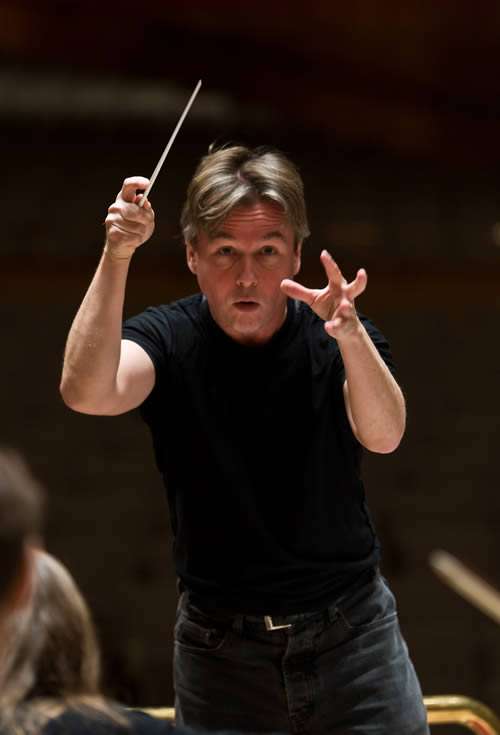|
Back
Challenge Accepted Chicago
Orchestra Hall, Symphony Center
02/28/2013 - & March 1, 2, 2013
Jean Sibelius: Pohjola's Daughter, Op. 49 – Symphony No. 7, Op. 105
Witold Lutoslawski: Cello Concerto
Peter Ilyich Tchaikovsky: Francesca da Rimini, Op. 32
Yo-Yo Ma (cello)
Chicago Symphony Orchestra,
Esa-Pekka Salonen (conductor) 
E.P. Salonen (© Clive Barda)
Great performers challenge their audiences. Through new interpretive stances in standard works to fierce commitment to the unfamiliar, Esa-Pekka Salonen and Yo-Yo Ma stand at the vanguard of individual artists whose mission is one of constant curiosity and exploration, and the CSO is the perfect partner for their collaboration. Together, the musicians brought stunning virtuosity to a daring program, and made believers out of the audience, who rose to their feet several times.
The first half's thoughtful coupling of Sibelius' mid-period tone poem Pohjola's Daughter with his final abstract symphonic essay encapsulated nearly all the best aspects of the composer's music. The only thing missing was an example of his superb, distinctive vocal writing. A primordial ether frames the first work, the opening low woodwinds and solo cello an instant evocation of the forlorn. In the middle, the eponymous character appears, shimmering high above. While the future Sibelius, who could suavely shift from texture to texture, emerges from time to time, there is more direct juxtaposition than transition in this tone poem. Exceptional solos came from John Bruce Yeh, whose clarinet playing was a highlight of the entire evening, and the orchestra's brass produced an impossible range of dynamics in their sforzando-piano gestures near the work's end. The fine playing complemented Salonen's expert handling of the ebbs, flows and (occasional) jerks in Sibelius' score.
In the Seventh Symphony, Salonen was brilliant in negotiating the large structural transitions, while some of the local crossplay between woodwinds and strings came close to falling behind the beat. The work is one of the great essays in the genre, and the Chicago musicians played with an appropriate, subtle power. The trombone refrains emerged from the textures underneath instead of attempting to dominate them, the strings moved with ease from tempestuous swirling to Palestrina-esque chorales, and the all-important timpani part was perfectly placed and balanced. The orchestra's organic unity mirrored the music's structural ingenuity. This was a memorable performance, making one bemoan the fact that Sibelius' symphonies are a glaring omission from the CSO's commercial discography.
Lutoslawski's Cello Concerto may not have been what many audience members expected when they bought a ticket to hear Yo-Yo Ma. They were removed from their comfort zone after the acclaimed cellist exceeded the first dozen repeated, indifferent D's. The disorientation began to be compensated for by giggling, shifting in seats and a sudden plague of coughs. Ma persisted in being not only a virtuoso cellist, but also a stoic actor and patient tour guide, inviting the audience into the unfamiliar realm of Lutoslawski's masterpiece, coaxing them to listen to the convivial and argumentative repartee he shared with his colleagues on stage, relishing the invention of the composer's timbral palette, and thrilling in the athletic final section of the piece.
This is not so much a deconstruction of the concerto genre, but a reconstruction. Raw materials are familiar, but the shuffling, layering and juxtaposition are startling. Brass fanfares, built on the opening interval of something as familiar as Taps, become surreal, and everything is discombobulated until the soloist is joined by the entire string complement of the orchestra, in unison, to affirm the doleful central melody. By this point in the performance, the audience was on board with the musicians, and the acceleration into the work's raucous finale brought us to a battlefield of joyous cacophony. Salonen threw cues into the air like Jackson Pollock working on a canvass, the orchestra responding with splashes of sonic color, while Ma rebutted with shouts, screams and squeals darting in and out of the textures. The myriad units fit together like clockwork, and the crushing chords of the work's climax, followed by Ma's last solo ascent, created the negative image of the deep netherworld of Pohjola's Daughter's opening bars. The expertise of the performance showed that even the unfamiliar communicates with visceral ease to those who trust its advocates.
If anything, the excellence and ingenuity of the trio of works preceding Francesca da Rimini made Tchaikovsky's tone poem, despite its thrilling brass passages, feel flimsy. Salonen channeled Stokowski, emphasizing the bombast of the piece, and from the orchestra, Yeh once again impressed in his clarinet solos, the brass raised hairs with enormous tone and technical panache. Tchaikovsky's "Dante Fantasy" is sonically impressive, but always feels superficial, and in this concert it was as if we had just enjoyed three perfectly executed, imaginative courses at "French Laundry", and were then taken to "Dairy Queen" for dessert. This is a minor qualm, however, and Ma, Salonen and the excellent Chicago musicians deserve the highest praise for committing to an imaginative, challenging program and leading the audience through it with technical brilliance and interpretive expertise.
Marcus Karl Maroney
|